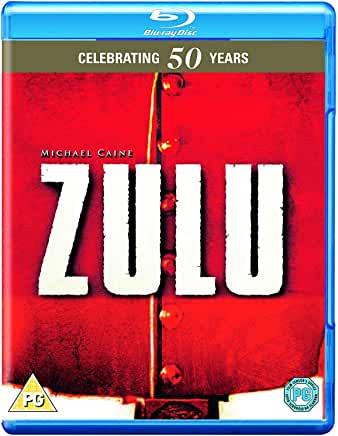Zulu on Blu-Ray

In late 1878, British authorities in Cape Town sent an ultimatum to the then Zulu king, Cetshwayo, with demands he couldn't agree to without surrendering Zulu autonomy. Without clearance from London, the ultimatum exceeded Cape Town's authority. But the Cape Town leaders knew, given the glacially slow communications of the day, that when the ultimatum led to war, as it did, a swift British victory over the Zulus would present London with a fait accompli.
But once in Zululand the commander of the British troops, Lord Chelmsford, divided his forces. He left 1500 men behind in reserve at the base of a mountainous outcropping, Isandlwana, while he marched the bulk of his army off to where he expected to encounter the main Zulu force. He was wrong; 25,000 Zulus descended on and slaughtered most of the Isandlwana contingent. The loss there of at least 1000 men remains the most crushing defeat in British military history at the hands of an opposing force with inferior weaponry.
Several miles away was Roark's Drift, a small mission converted by Lord Chelmsford into a rear supply depot and hospital. It was manned by a small force of roughly 150. While Isandlwana was in Zulu territory, Rorke's Drift was across the Buffalo River, the boundary between British Natal and Zululand. Cetshwayo had commanded the Zulus not to cross the river. He didn't want all-out war with the British and responded only to Chelmsford's incursion into Zululand. But a reserve contingent of roughly 4000 Zulus, which saw no action at Isandlwana, wanted a share of the glory. Or at least their leader, the half-brother of Cetshwayo, wanted his share. Rorke's Drift was a juicy plumb, lightly manned and ripe for the taking.
That's the background of the superb 1964 film Zulu, which depicts only the battle of Rorke's Drift. The fight there began mere hours after the Isandlwana debacle and continued on through the following night. Fortunately, due to the status of the facility as a depot and hospital, the small contingent there had plenty of equipment on hand, including ample ammunition. Other supplies, such as wagons and hundreds of heavy mealie bags (much like sandbags but filled with grain) were available to link the isolated buildings together, turning Rorke's Drift into a small fortress.
As the battle raged the Zulus were able to break through the original perimeter, forcing the British soldiers to retreat into smaller and smaller fortified sections. While the Zulus were able to set the hospital building on fire, this proved a blessing for the defenders. The fire burned on into the night, illuminating the area and preventing the Zulus from launching a serious attack in the dark. (This important detail is not emphasized in the film. The night action is ignored, likely because the film stock of the day wasn't well suited to night scenes. Google "day-for-night" if you want to know more).
The Zulus backed off the next morning and the battle ended. The casualties at Rorke's Drift were high on both sides, but most of the British company survived. Eleven of them later received the Victoria Cross (the British equivalent of the Congressional Medal of Honor).
The film was directed by Cy Endfield and stars a slew of major British actors of the day, including Stanley Baker, Jack Hawkins, Nigel Green and, (in his most prominent early film role), Michael Caine. Richard Burton (unseen) narrates. The film was a major box office hit in 1964. It was also a TV staple for years, popular for home viewing despite being limited to the 4:3 screens standard definition of the day. It can still be viewed via streaming, but instead I seriously recommend the 50th anniversary Blu-ray release (in the red jacket shown above). The stereo audio on this disc is satisfactory though underwhelming. But its widescreen video is exceptional, whether viewed as I did on both a 64-inch OLED or projected onto an 96-inch (wide, not diagonal) 2.35:1 screen. The video transfer here can compete with today's best 5-star Blu-rays. It's a hidden gem both dramatically and visually. The fact that nearly all of the film takes place in bright sunlight certainly helps.
While Zulu provides few details about the massacre at Isandlwana that preceded the battle at Rorke's Drift, I can also recommend the 1979 film Zulu Dawn. It covers Isandlwana thoroughly. It's not the equal of Zulu. But this prequel (while produced much later) offers plenty of action of its own and is well made overall (though the star billing of Burt Lancaster is a bit misleading since his role is neither large nor particularly important). I watched it on YouTube in decent quality, but this source wasn't the video equal of on Blu-ray.
How accurate is Zulu ? Reasonably so, given that movies often butcher historical events. For more details on this I highly recommend the YouTube channel History Buffs. While this site isn't as active recently as it was a few years ago, all of its entries are still available. While its review of Zulu points out a few inaccuracies, it's generally quite positive on the film.
























































